APPS
5 Resources to Build Your App Idea
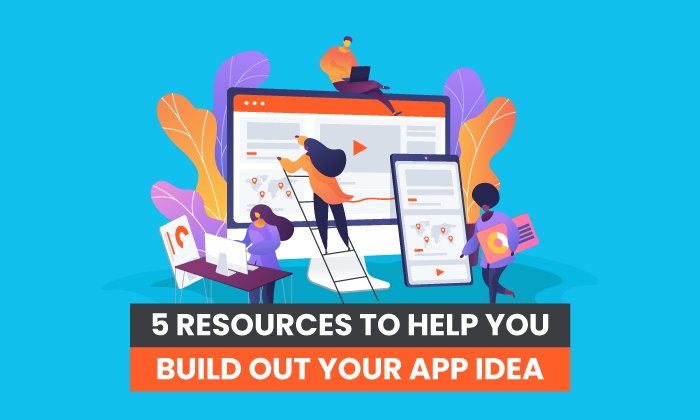
Considering building an app? You’re in good company.
The mobile app industry is expected to be worth more than $407 billion (yes, with a B) by 2026.
Meanwhile, the average person has more than 80 apps on their phone. That represents a ton of opportunities for app builders.
However, if you think creating an app is an easy way to get rich, you are setting yourself up for failure. Building an app requires research, hard work, and a willingness to dive in and learn.
Luckily, there are tons of resources to get you started—including this guide. Below, I’ll walk you through how to build out your app idea and then share five resources to help you launch your app.
How to Build Out Your App Idea
Like any business, creating an app requires laying the groundwork before launch. Here’s a five-step guide for getting ready to launch your app, including how to do your research, ways to monetize your app, and what to include in your business plan.
Build an App Step 1: Do Market Research
Before you dive into creating your app, you first need to get a lay of the land. Who is your target audience? What other apps offer similar features or functionality? How does your app stand apart?
Start by creating a buyer persona map, which will help you understand who your audience is and what they want. Use this information to create a detailed sales plan, decide what features to include, and choose where to market your app.
Then, perform a competitive analysis to understand your competitors. The information you gain from this will be critical as you build and grow your app. Focus on what current apps do well and what they don’t. The areas where they fail can present opportunities for you to improve and take over part of their market.
For example, if your goal is to build an app that offers workout and diet recommendations, take the time to download similar apps and read their reviews. What features do people ask for, and what features do they dislike? Who is using these apps? How are they monetized?
Be thorough—you’ll use this information in the next few steps.
Build an App Step 2: Decide How to Monetize Your App
There are several ways to make money from an app. The right choice for your app likely depends on your industry, target audience, and the type of app you create. For example, games are often monetized by ads and in-app purchases, while dating apps generally charge a monthly subscription fee.
Consider each of the following monetization methods to decide which is right for your app:
- Ads: Create a free app and earn money by selling ads in your app. Duolingo uses this model, though they also offer a paid plan.
- In-app purchase: Provide a free app and then allow users to purchase add-ons, like Pokemon Go does.
- Freemium: Give users access to a limited plan for free and then charge them to access all the features, like the meditation app Mindfulness does.
- One-time payment: Charge a one-time fee to access the app. Just keep in mind you won’t have a continuing income stream for updates, redesigns, and marketing.
- Monthly subscription: Charge a small fee every month for access to the app. This helps you maintain a steady stream of income, making it easier to pay salaries and invest in marketing.
Many apps use multiple monetization methods. For example, you might offer a limited free plan and then charge a monthly subscription fee to access all features. You might even use ads to monetize the free plan and offer a paid plan that is ad-free.
There are pros and cons to each monetization method. Some users might be annoyed by too many ads or hate paying for subscription services. See what other apps in your industry do, but don’t be afraid to break the mold by trying out a different method.
Build an App Step 3: Create a Business Plan
Most people assume building an app is all about coding, but the real work actually starts long before you create your first line of code (or before you begin building it if you use an app builder).
After you get to know your audience and decide how to monetize your app, take the time to create a business plan. This plan should guide your first few years in business and keep you committed to your app’s core purpose.
According to the Small Business Administration, your business plan should include:
- Executive summary: A brief outline of your company, what you will offer, and basic information about your leadership team, location, and plans for growth.
- Company description: A detailed guide covering what problem your business will solve, who your app will serve, and what competitive advantages your app offers.
- Market analysis: A summary of your market research that covers what your app’s strengths are, trends you take advantage of, and how your app stacks up against others in the same industry.
- Structure and management: An explanation of who’s in charge of your business and how your company is structured. Are you creating a C corp or an LLC, or are you a sole proprietor? Include a list of key leaders, their CVs and resumes, and even an outline of the benefits each person brings to the table.
- Offering: A description of what your app does and how it benefits customers. Include plans for patent filings or copyright, if applicable.
- Market and sales plans: An outline of your marketing strategy and how it will adjust over time. Cover how you plan to attract and keep customers, the sales process, and where you’ll focus your marketing efforts.
- Financial projections: Information about your costs, where that money will come from, and prospective profits. Costs of creating an app may be low (especially using the app tools we’ll cover in the next section), but you’ll still need money for things like web hosting, paid ads, etc. Forecast sales for the first year, five years, and ten years, and make sure to explain how you reached those numbers and outline where funding will come from.
Build an App Step 4: Create the App
Now that you’ve laid the groundwork, it’s time to actually create your app. This might feel a little overwhelming, but it doesn’t have to be. You have three main options for building your app. Let’s explore the pros and cons of each one.
Code the App Yourself
If you are technologically savvy, you may be able to code the app yourself. Make sure you have a deep understanding of coding or the patience to learn.
Pros:
- cheap (it only costs your own time)
- full control over features, coding platforms, etc.
Cons:
- requires a deep understanding of coding
- time-consuming
Hire an App Builder
Hiring an app builder might be costly, but it could help you get the app to market faster than coding it yourself.
Pros:
- launch faster
- no need to learn coding languages
Cons:
- can be expensive
- less control over features
Use an App Building Tool
Remember when building a website required expensive programs and in-depth coding skills? Now you can build a website with just a few clicks. App building tools offer the same functionality for apps.
Pros:
- faster and easier than coding or hiring an app builder
- likely cheaper than hiring someone to build your app
- get to market faster
Cons:
- limited by the app builder’s functionality
- have to pay to use most (though they are typically affordable)
Build an App Step 5: Launch & Submit to App Stores
Once your app is built, you’ll need to test it before launch. Ask a few friends to download the app and tell you what you think. Consider using a mobile UX testing tool to see how users navigate your app and make adjustments before you launch.
Then, you’ll need to submit your app to app stores, which is where users will download it. The most popular app stores are Apple’s App Store and Google Play. Follow this guide to submit your app to the App Store and this one to submit to Google Play.
Don’t forget to optimize for app SEO! This will help you rank higher so people actually find your app.
5 Resources to Help You Build Your App
Creating an app is easier than ever, thanks in part to the variety of app tools that help you build and launch a mobile app. However, with so many options, it can be challenging to figure out which one to use.
Let’s review a few of the top app tools so you can find the right one for you.
iBuildApp
iBuildApp is a full-featured app builder that provides all the tools you need to build an app using its drag-and-drop functionality. Start with any one of their 1000+ templates, then drag and drop features to add video, images, text, and more.
This tool is ideal for building apps for e-commerce stores, education, healthcare, business, media, retail, and financial services. Brands such as the U.S. Navy, Whole Foods, SEGA, and Emory University have used this tool.
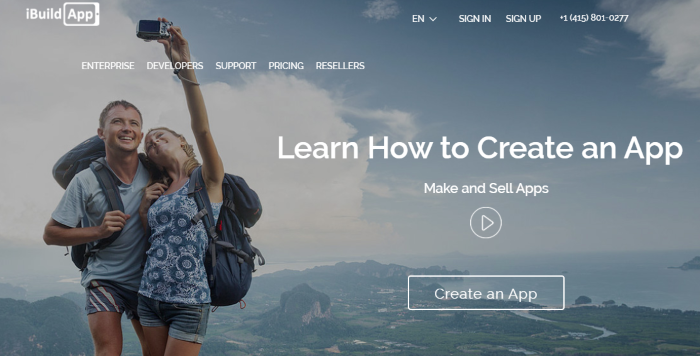
Price: Starts at $59.40 per month for one app.
Appy Pie AppMakr
Want to build an app but don’t have any coding experience? Appy Pie helps you build an app in just three steps. Choose from over 100 features, including GPS, in-app shopping, offline capabilities, and push notifications. They also offer analytics so you can measure app performance.
You can use it to create apps for dating sites, customer reward programs, chatbots, retail, restaurants, and more. They’ll even help you submit the app to app stores.
Appy Pie is used by brands like The Home Depot, Southwest, and Nike.
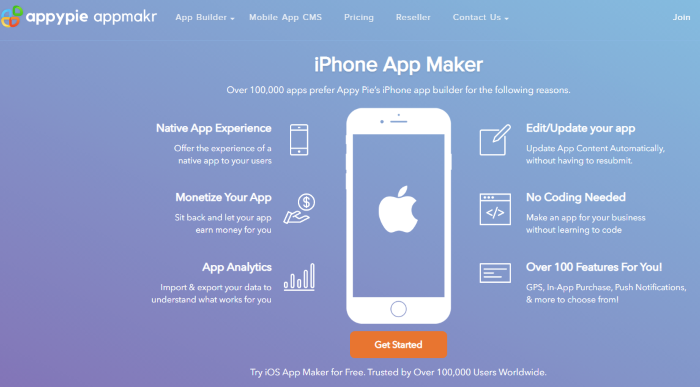
Price: Options start at $18 per month for an ad-free experience, and they also offer a free trial.
BuildFire
BuildFire is a full-featured app development tool that allows you to build an app with no coding. Use their templates and then customize your app with hundreds of features like push notifications, clocks, private portals, loyalty programs, checklists, forms, or media.
They also offer a white-label feature, which allows you to build and sell apps to clients.
Though pricier than other options, this app build tool offers a lot more tools and features, so it’s an ideal choice for building more detailed apps.
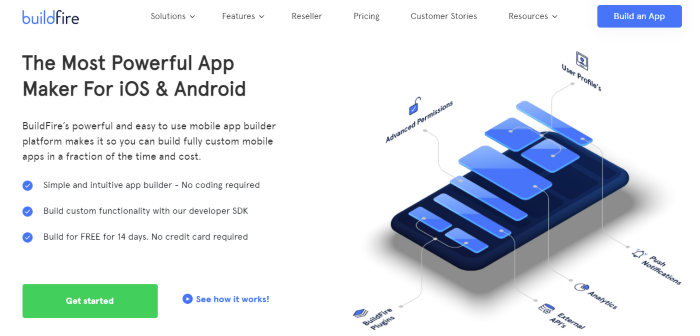
Price: Plans start at $159 per month, billed annually.
Usability Geek
Creating an app is just the first step—you also need to test the user experience. Usability Geek provides tools, resources, and UX testing guides to help your app succeed. Explore their UX courses and blog posts about usability to learn the skills you need to help your app succeed.
Offered courses cover a range of topics, including the Psychology of E-Commerce, How to Create a UX Portfolio, and Quantitative Research for UX. Some courses even offer certification.

Price: Usability Geek offers free blogs about usability testing as well as paid training courses that start at $16 per month.
GoodBarber
GoodBarber is an easy-to-use app build tool designed for both e-commerce and standard app building. Like many other app tools, it doesn’t require any coding knowledge.
This tool is ideal for building apps for local delivery, retail, grocery, e-commerce, news, business, and community. Features include adding payment options, push notifications, user authentication, geofencing marketing, videos, maps, calendars, and forms.
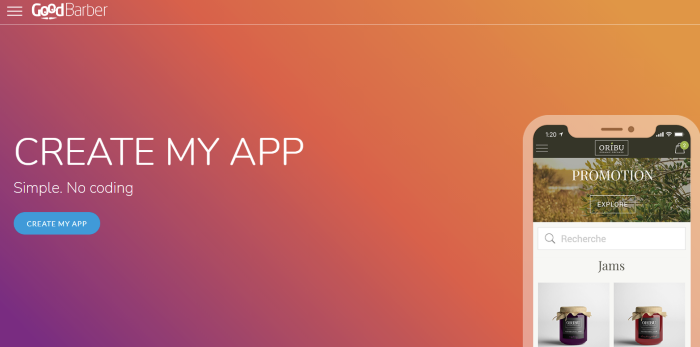
Price: Pricing starts at $25 per month for one app and includes SEO optimization, domain name, SSL security, 200 GB of storage, and unlimited pages.
They also offer reseller plans, which start at $200 per month.
Conclusion
With the help of app build tools, launching an app is easier than ever. With little to no coding knowledge, you can create, launch, and optimize your new app in just a few days.
However, building a successful app is about more than just dragging and dropping features. To be successful, take the time to create a business and marketing plan, research your target audience, and make a plan for funding your venture.
Have you built an app before? What app build tools were most helpful to you?
See How My Agency Can Drive Massive Amounts of Traffic to Your Website
- SEO – unlock massive amounts of SEO traffic. See real results.
- Content Marketing – our team creates epic content that will get shared, get links, and attract traffic.
- Paid Media – effective paid strategies with clear ROI.
APPS
Best ASO Tips To Boost Your App Search In 2022

You need your application to be really effective in the overpopulated application market. Then, at that point, you will have to drive downloads to endure. So when it’s all said and done, you must account for yourself. Get your application the consideration it merits.
The uplifting news, however, is that customers love to download applications – last year, we downloaded in excess of 200 billion applications around the world, and that figure is set to increment to 258 billion every year by 2022 as cell phone reception increments.
Assuming you need to be seen and have your application downloaded by however many clients as could reasonably be expected, then, at that point, you should begin by taking a gander at the application store.
Underneath, we’ve assembled probably the best application store improvement methods to assist you with creating more downloads in 2021 and then some…
Start with Your Application Name
The odds are you as of now have an extraordinary name for your application, yet an appropriately advanced application is about significantly more than marking.
Assuming you need to amplify transparency and guarantee you’re showing up when clients look for applications like yours, you ought to remember the primary keywords for your application name or title, comparable to how you’d make a title label while improving a site page.
You could begin with your application name so it tends to be plainly recognized, thus it appears on the home screen of gadgets.
Then, at that point, you can add a scramble or vertical bar prior to adding a few pertinent watchwords to your speciality, or even put your application name in quotes as we did with FORE Business Golf Networking.
Urge Users to Leave Reviews
You could ask for reviews by clients through the means of your site, or through an in-application notice toward the finish of their meeting, yet make sure to restrict the number of pop-ups you execute with the goal that you don’t disturb or disappoint your clients, as this could urge them to erase your application.
We’d support all application engineers and entrepreneurs to react to criticism on their applications, as this can further develop client relations and resolve issues in an open arena.
Zero in on Your Application Depiction
Your application depiction is your principle assemblage of text your landing page content, in a manner of speaking. Utilize a site like KeywordTool.io to discover information on your picked catchphrases to expand your openness. As portrayals are shortened, ensure you remember the main data for the initial three lines of your depiction, and afterwards add things like social confirmation, emoticon, and suggestions to take action to build commitment and downloads.
Incorporate Appealings Screen Captures
Pictures and recordings won’t help your application rank, yet they will expand changes and assist clients with working out whether it’s an application they truly need.
There’s a little guide in empowering clients toward downloading your application if in any case, they’re not going to interface with it, or download and leave a negative survey when they understand it wasn’t what was promoted.
Assuming you need to ‘tart up’ your item page, then, at that point, you can add marking and extra text and data and designs to your recordings and screen capture, yet they ought not to diminish your item.
Pay for App Store or Play Store
As we have SEO and pay-per-click, you need to work one next to the other (one is a gradual methodology with long haul benefits – the other is a speedy success yet requires an endless spending plan), application store promotions can be utilized to get the message out with regards to your new programming and assist you with positioning at the highest point of query items pages – in front of your opposition and enormous names in the application world.
Keep in mind, you’ll need to focus on the right crowd and art an advertisement that will assist you with changing over and that since you’re paying for situations, that doesn’t mean clients will download or cooperate with your application.
Wrapping Up!
You can employ a group of App Store Optimization Services suppliers to benefit a scope of application store improvement administrations, including watchword advancement, resource enhancement, and restriction to guarantee your application is seen by individuals that matter.
We have long periods of involvement in creating and showcasing applications and have assisted different customers with expanding their downloads by infiltrating rewarding and regularly undiscovered business sectors.
Author:
Prachi Gupta likes to write information about Digital Marketing Trends that can help audience to grow their business.
APPS
WhatsApp will finally let users encrypt their chat backups in the cloud
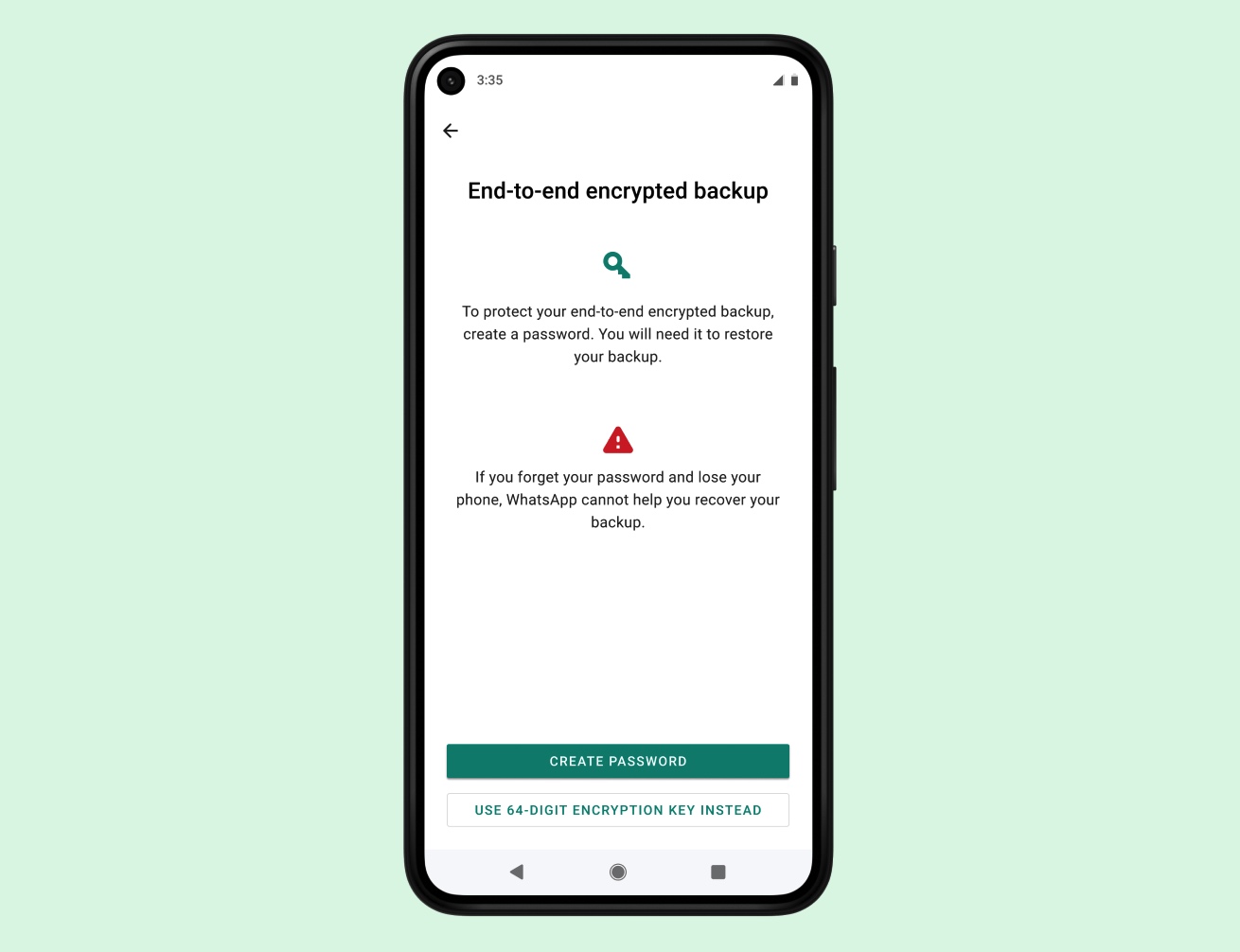
WhatsApp said on Friday it will give its two billion users the option to encrypt their chat backups to the cloud, taking a significant step to put a lid on one of the tricky ways private communication between individuals on the app can be compromised.
The Facebook-owned service has end-to-end encrypted chats between users for more than a decade. But users have had no option but to store their chat backup to their cloud — iCloud on iPhones and Google Drive on Android — in an unencrypted format.
Tapping these unencrypted WhatsApp chat backups on Google and Apple servers is one of the widely known ways law enforcement agencies across the globe have for years been able to access WhatsApp chats of suspect individuals.
Now WhatsApp says it is patching this weak link in the system.
“WhatsApp is the first global messaging service at this scale to offer end-to-end encrypted messaging and backups, and getting there was a really hard technical challenge that required an entirely new framework for key storage and cloud storage across operating systems,” said Facebook’s chief executive Mark Zuckerberg in a post announcing the new feature.
Store your own encryption keys
The company said it has devised a system to enable WhatsApp users on Android and iOS to lock their chat backups with encryption keys. WhatsApp says it will offer users two ways to encrypt their cloud backups, and the feature is optional.
In the “coming weeks,” users on WhatsApp will see an option to generate a 64-digit encryption key to lock their chat backups in the cloud. Users can store the encryption key offline or in a password manager of their choice, or they can create a password that backs up their encryption key in a cloud-based “backup key vault” that WhatsApp has developed. The cloud-stored encryption key can’t be used without the user’s password, which isn’t known by WhatsApp.
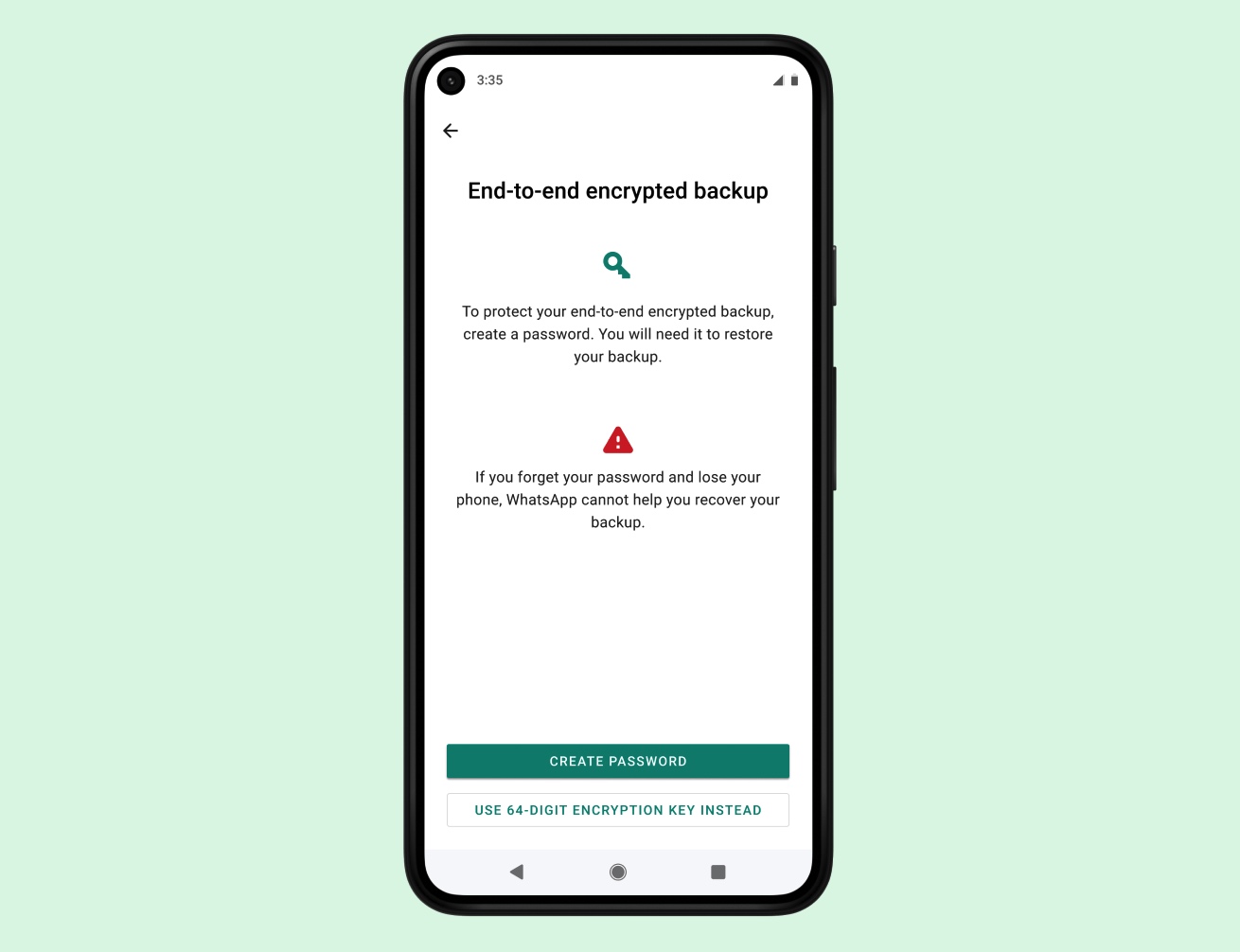
Image Credits: WhatsApp/supplied
“We know that some will prefer the 64-digit encryption key whereas others want something they can easily remember, so we will be including both options. Once a user sets their backup password, it is not known to us. They can reset it on their original device if they forget it,” WhatsApp said.
“For the 64-digit key, we will notify users multiple times when they sign up for end-to-end encrypted backups that if they lose their 64-digit key, we will not be able to restore their backup and that they should write it down. Before the setup is complete, we’ll ask users to affirm that they’ve saved their password or 64-digit encryption key.”
A WhatsApp spokesperson told TechCrunch that once an encrypted backup is created, previous copies of the backup will be deleted. “This will happen automatically and there is no action that a user will need to take,” the spokesperson added.
Potential regulatory pushback?
The move to introduce this added layer of privacy is significant and one that could have far-reaching implications.
End-to-end encryption remains a thorny topic of discussion as governments continue to lobby for backdoors. Apple was reportedly pressured to not add encryption to iCloud Backups after the FBI complained, and while Google has offered users the ability to encrypt their data stored in Google Drive, the company allegedly didn’t tell governments before it rolled out the feature.
When asked by TechCrunch whether WhatsApp, or its parent firm Facebook, had consulted with government bodies — or if it had received their support — during the development process of this feature, the company declined to discuss any such conversations.
“People’s messages are deeply personal and as we live more of our lives online, we believe companies should enhance the security they provide their users. By releasing this feature, we are providing our users with the option to add this additional layer of security for their backups if they’d like to, and we’re excited to give our users a meaningful advancement in the safety of their personal messages,” the company told TechCrunch.
WhatsApp also confirmed that it will be rolling out this optional feature in every market where its app is operational. It’s not uncommon for companies to withhold privacy features for legal and regulatory reasons. Apple’s upcoming encrypted browsing feature, for instance, won’t be made available to users in certain authoritarian regimes, such as China, Belarus, Egypt, Kazakhstan, Saudi Arabia, Turkmenistan, Uganda and the Philippines.
At any rate, Friday’s announcement comes days after ProPublica reported that private end-to-end encrypted conversations between two users can be read by human contractors when messages are reported by users.
“Making backups fully encrypted is really hard and it’s particularly hard to make it reliable and simple enough for people to use. No other messaging service at this scale has done this and provided this level of security for people’s messages,” Uzma Barlaskar, product lead for privacy at WhatsApp, told TechCrunch.
“We’ve been working on this problem for many years, and to build this, we had to develop an entirely new framework for key storage and cloud storage that can be used across the world’s largest operating systems and that took time.”
APPS
Dispo launches a test to gauge user interest in selling their photos as NFTs
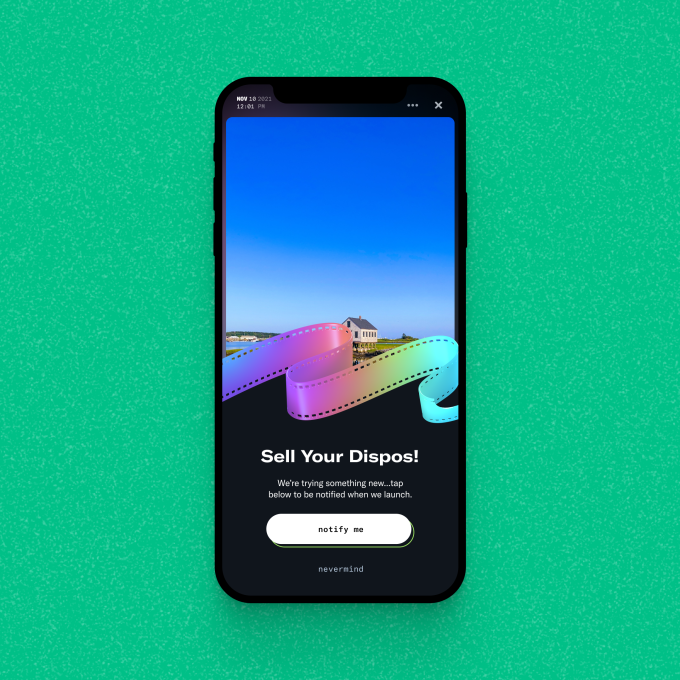
Dispo, the photo-sharing app that emulates disposable cameras, started rolling out a test yesterday that will record user interest in selling photos as NFTs. Some users will now see a sell button on their photos, and when they tap it, they can sign up to be notified when the ability to sell Dispo photos launches.
CEO and co-founder Daniel Liss told TechCrunch that Dispo is still deciding how it will incorporate NFT sales into the app, which is why the platform is piloting a test with its users. Dispo doesn’t know yet what blockchain it would use, if it would partner with an NFT marketplace or what cut of sales Dispo would take.
“I think it’s safe to say from the test that there will be an experience native to the Dispo app,” Liss said. “There are a number of ways it could look — there could be a native experience within Dispo that then connects through an API to another platform, and in turn, they’re our partner, but to the community, it would look native to the Dispo app.”
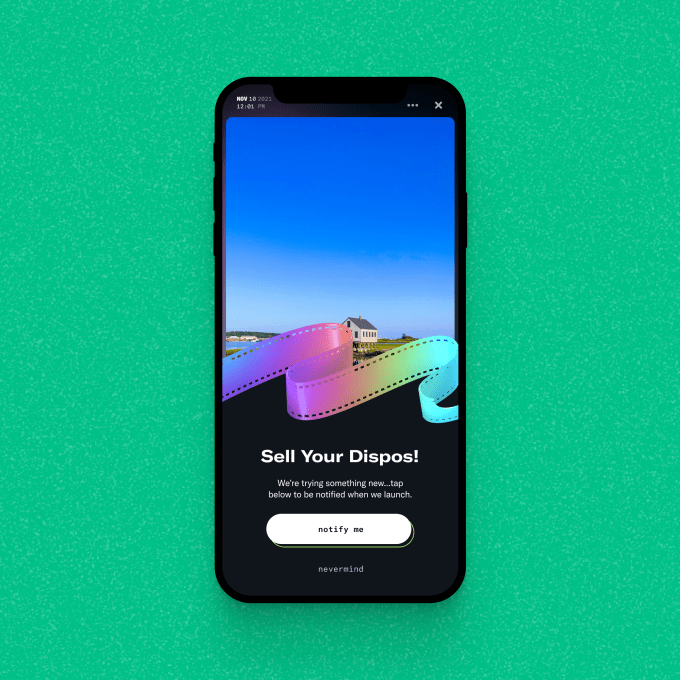
Image Credits: Dispo
This marks a new direction for the social media app, which seeks to redefine the photo-sharing experience by only letting users see the photos they took at 9 AM the next morning. From Dispo’s perspective, this gimmick helps users share more authentically, since you take one photo and then you’re done — the app isn’t conducive to taking dozens of selfies and posting the “best” image of yourself. But though it only launched in December 2019, Dispo has already faced both buzzy hype and devastating controversy.
Until about a year ago, the app was called David’s Disposables, named after co-founder and YouTuber David Dobrik. The app was downloaded over a million times in the first week after its release and hit No. 1 on the App Store charts. In March 2021, the app dropped its waitlist and relaunched with social network features, but just weeks later, Insider reported sexual assault allegations against a member of Vlog Squad, Dobrik’s YouTube prank ensemble. In response, Spark Capital severed ties with the company, leading to Dobrik’s departure. Other investors like Seven Seven Six and Unshackled Ventures, which contributed to the company’s $20 million Series A round, announced that they would donate any profits from their investments in Dispo to organizations working with survivors of sexual assault.
Liss told TechCrunch in June, when the company confirmed its Series A, that Dobrik’s role with the company was as a marketing partner — Liss has been CEO since the beginning. In light of the controversy, Liss said the app focused on improving the product itself and took a step back from promotion.
According to data from the app analytics firm SensorTower, Dispo has reached an estimated 4.7 million global installs to date since launch. Though the app saw the most downloads in January 2020, when it was installed over 1 million times, the app’s next best month came in March 2021, when it removed its waitlist — that month, about 616,000 people downloaded Dispo. Between March and the end of August, the app was downloaded around 1.4 million times, which is up 118% year over year compared to the same time frame in 2020 — but it should be expected that this year’s numbers would be higher, since last year, the app’s membership was exclusive.

Image Credits: Dispo
Now, with the announcement that Dispo is pursuing NFTs, Liss hopes that his company won’t just change how people post photos, but what the relationship will be between platforms and the content that users create.
“Why NFTs? The most powerful memories of our lives have value. And they have economic value, because we created them, and the past of social media fails to recognize that,” Liss told TechCrunch. “As a result, the only way that a creator with a big following is compensated is by selling directly to a brand, as opposed to profiting from the content itself.”
Adding NFT sales to the app offers Dispo a way to profit from a cut of user sales, but it stands to question how adding NFT sales could impact the community-focused feel of Dispo.
“I think there is tremendous curiosity and interest,” Liss said. “But these problems and questions are why we need more data.”
-

 SEARCHENGINES5 days ago
SEARCHENGINES5 days agoBillions Of Google goo.gl URLs To 404 In The Future
-

 SEO7 days ago
SEO7 days ago26 Common SEO Myths, Debunked
-
SEARCHENGINES4 days ago
Daily Search Forum Recap: July 22, 2024
-

 SEARCHENGINES6 days ago
SEARCHENGINES6 days agoGoogle Core Update Coming, Ranking Volatility, Bye Search Notes, AI Overviews, Ads & More
-

 SEO5 days ago
SEO5 days ago11 Copyscape Alternatives To Check Plagiarism
-

 SEO6 days ago
SEO6 days agoGoogle Warns Of Last Chance To Export Notes Search Data
-
SEARCHENGINES3 days ago
Daily Search Forum Recap: July 23, 2024
-

 AFFILIATE MARKETING6 days ago
AFFILIATE MARKETING6 days agoThe Top 5 AI Tools That Can Revolutionize Your Workflow and Boost Productivity















